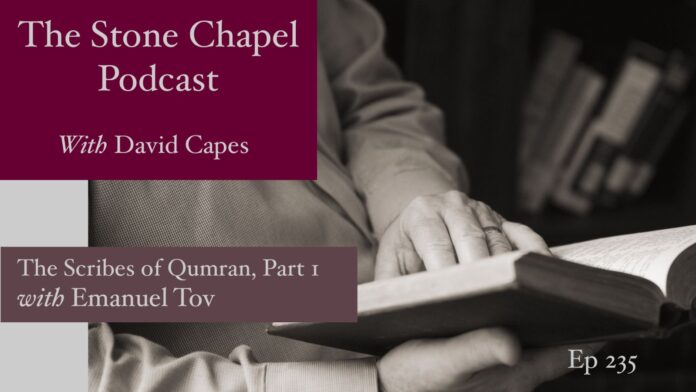► Listen on Amazon
► Listen on Apple
► Listen on Spotify
► Listen on YouTube
You can find previous episodes of “The Stone Chapel Podcast” at Lanier Theological Library.
“The Stone Chapel Podcast” is part of the ChurchLeaders Podcast Network.
This transcript has been edited for clarity and space.
Emanuel Tov
I’m Emmanuel Tov. J. L. Magnus, Professor of Bible at the Hebrew University of Jerusalem, Israel.
David Capes
Dr Emmanuel Tov. Emanuel, good to see you back here at the Lanier Theological Library. Welcome. You’ve been on “The Stone Chapel Podcast” before.
Emanuel Tov
Well, thank you very much. It’s a great pleasure being back here. It’s nice weather and an excellent library. I’m glad to do my research here again and be back with nice people.
David Capes
Well, you’re working on a book that we’ll be talking about later, and you’re giving a lecture here on April 5th, 2025, on “The Scribes of Qumran.” I asked you if we could do a little bit of a primer to talk about your lecture topic to encourage people to come and join us. But for those who may hear the podcast after the lecture, they can find the lecture video online on our YouTube channel and listen for themselves.
Emanuel Tov
I’ll be talking about “The Scribes of Qumran,” or the scribes of the Dead Sea Scrolls. Now some of you may not know exactly what I mean by scribes, because the word scribes has a different meaning today than in the Middle Ages and in ancient times. I’m talking about scribes in ancient times, more or less in the times of Jesus. Now, scribes are not the scribes that you may be used to in the New Testament. They are scribes, more or less of a political nature, a political unit.
The scribes I talk about are scribes that do a job. They are copyists. They copy a text. They sat on their chairs and they copied on their laps or something like a desk. They had in front of them a text from which they copied, and they copied to make a new text. They created a new text from an old text. You might say some of them also created a completely new text without a text in front of them. All these people are called scribes.
There are really several types of scribes, and of course, they don’t exist only in the world about which I made my study, the scribes of the Dead Sea Scrolls. They exist in ancient Mesopotamia. They exist in particular in ancient Egypt, where we even have very famous depictions of these scribes. You can see the Egyptian scribes sitting on the ground and writing on their laps. You see these depictions in various museums. They are very famous, these scribes.
Now, exactly how the scribes of the Dead Sea Scrolls were sitting, we don’t know. But there is one spot in the place of Qumran, near the Dead Sea. We call this the scriptorium, a room in Qumran. We call this room number 30, where we found ink wells as well as tables, and what we call tables and benches. We think that in this particular place, some scribes, let’s say some 30 scribes, were seated in a room. Some scholars say that they were dictated to. But I don’t believe in the theory of dictation. I think many scribes were seated in this room, and they had enough room on these tables to spread out pieces of leather, because you need a lot of room in order to have your piece of leather in front of you.
And there they wrote their new scrolls, because at that time, we didn’t yet have the book form of written creations. The book form was only created afterwards with the promulgation of Christian scriptures. So, we are talking about the form that we are used to today in the Jewish synagogue; The ancient roll or scroll, that is, pieces of leather which were sewn together, not glued, but sewn together with strings. These scribes used certain techniques about which we can talk later on, and they did a wonderful job. From their job, we can learn many things, not only about the scribes, but also about the books themselves that they copied, that they created.
David Capes
Now, when you say Qumran, there are a lot of people that know something about that. Maybe they’ve heard of the Dead Sea Scrolls, for example. But when you say the scribes of Qumran were these all copyists associated with the Qumran group, with that particular group, or were they hired out to do this job?
Emanuel Tov
There’s no real archeological information about the scrolls or the scribes of the Dead Sea Scrolls. Everything we know is by inferring data from the scrolls by thorough study that we have done over the course of now half a century. So, everything is theory. In the beginning, when the scrolls were found in 1947-1948, people thought that all these scrolls found at Qumran in a dry region at the shore of the Dead Sea were actually copied on the spot.
Now we have become more wise, and according to my own theory, one-third of the scrolls that were found near the Dead Sea were copied on the spot, and two-thirds were imported by the people who lived in Qumran from outside Qumran. So, when we talk about the scribes of the Dead Sea Scrolls, it’s a little bit misleading, because these are really not the scribes of Qumran. These are the scribes of ancient Israel, of ancient Palestine that we get to know from this wonderful treasure of scrolls that were found at Qumran, it’s the whole world of ancient Israel that we learn from these scrolls that were found at one spot.

